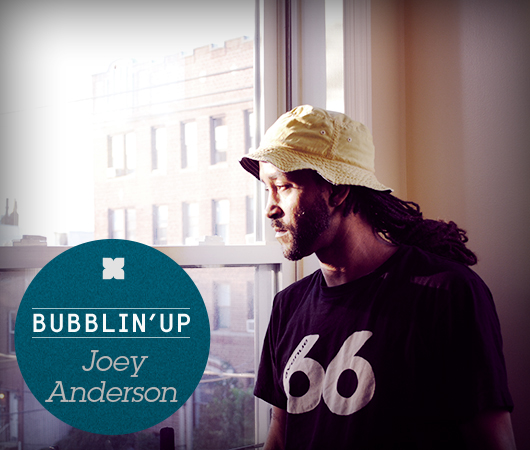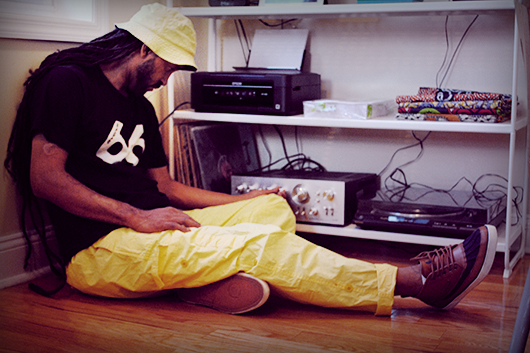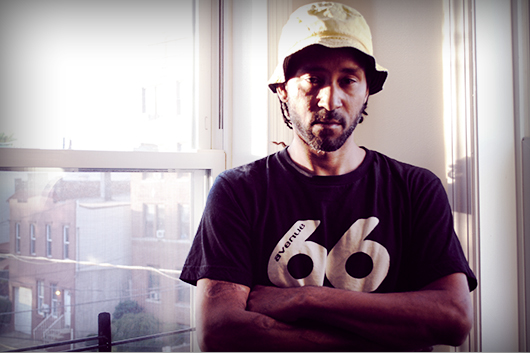Bubblin’ Up: Joey Anderson
There’s something happening on the East Coast. A new generation of veteran house heads, folks […]

Bubblin’ Up: Joey Anderson
There’s something happening on the East Coast. A new generation of veteran house heads, folks […]

There’s something happening on the East Coast. A new generation of veteran house heads, folks who are old enough to have been clubgoers in the late ’80s and early ’90s, are dipping their toes into production with often startling results. In truth, this isn’t a new phenomenon—it’s an ongoing process that has already birthed a number of contemporary talents, including artists like DJ Qu, Fred P, and Levon Vincent. Now, we can add another name to that list: Joey Anderson, a New Jersey-based producer and DJ who’s found himself on the brink of success.
Anderson’s first public release came in 2008, when his track “Thee Analysis” appeared on the Exchange Place EP from DJ Qu’s Strength Music imprint. The song was deep house as recorded from beyond leftfield, a piece of loose, dub-techno-indebted, 5 a.m. dance music with a vocal that simply declared, “ad hoc and ad libbed.” That record’s message, a commitment to improvisation, has stayed with the producer over the years, guiding his work through and beyond Earth Calls, his breakout 2012 EP on Levon Vincent’s and Anthony Parasole’s Deconstruct label. But while “Thee Analysis” may have declared Anderson’s intentions, the truth is that artistic improvisation has always been a part of his character.
He grew up in Hoboken, New Jersey, a town that sits in shadow of Manhattan, just a short trip across the Hudson from New York City. As a young man, he was first drawn to music as a dancer, an activity that he would ultimately spend a large part of his life pursuing at a competitive level. “When I was 11 years old, [dancing] was a popular thing in the neighborhood,” he recalls. “We did it for bragging rights; everyone wanted to be a good dancer. But I got a little serious and my friends were so competitive, so we just kept practicing, getting better and better.” Running with his friend DJ Qu, he soon branched out from Jersey and hit New York’s club scene, honing his chops on the underground dancefloors of yesteryear. Of these he remembers the Sound Factory, and its hard-hitting DJ Junior Vasquez, as being particularly influential. “It was a spot known for [house dancing],” says Anderson. “It’s where all the dopest dancers were. You’d see dancers you’d see in music videos—popular hip-hop videos and [videos from] Crystal Waters. You’d get a chance to see them dancing in [house dancing] circles and that was the attraction for us. You’d be learning the newest and rawest stuff. You’d get a first-hand look at the most popular thing, the newest thing going on.”

It was on the dancefloors of New York’s historic institutions that Anderson cultivated his own style of movement, something that’s chronicled today on his YouTube channel, which features videos of Anderson doing graceful footwork and balletic spins that occasionally branch into more abstract forms of interpretive dance. He says of his style, “When I was coming up, it was about being fluid and mobile while being as tight on the beat as possible—flowing. The flow was important because it showed you understood the style and the dance language. Nowadays it’s about floorwork and tricks—breaking, you know? In my time, you had to do both, but you got more respect when you had more language on fluid moves—dance moves, not tricks.” In the ’90s, he remembers seeing the clubs being flooded with Japanese dancers interested in learning the rites of East Coast house dancing. This drove him to become better, but it also led him take up a part-time job as a dance instructor, where he forged a bond with the Japanese house-dancing community and eventually built connections that would see him travel to Japan multiple times to compete.
This background in dance informs his music, though not necessarily in an easily understood way. He says of the connection, “When I’m dancing, I’m trying [to make people think], ‘How did you create that?’ That’s what my students used to [ask] me. Being creative and being able to think on the spot is an integral part of competitive dancing. When I sit down and start working on songs, in my productions I try to look for a spot where [I can] build to a point where [you think], ‘Why did he think of that? Why did he put that in there?”
As an example, Anderson points to “Earth Calls,” a sparse, five-minute track that layers splotchy piano melodies and circular, monophonic synth leads above a skipping kick drum. Around the four-minute mark, the track is joined by jarring, dubbed-out stabs that sound like severely mangled guitar power chords. They appear out of the blue, but their inclusion doesn’t feel extraneous; somehow, they fit and manage to elevate the song to another level entirely, placing the listener (or dancer) in a disoriented state that’s altogether welcome. Moreover, Anderson executes the whole thing with style, which helps explain why the track became so highly anticipated when it first debuted as the opening cut on Levon Vincent’s stellar Fabric 63 mix. It later went on to become one of the standout tunes of 2012, a unique American dance record destined to soundtrack dim, red-lit basement parties for years to come.
When Earth Calls dropped, it changed things for Anderson. Or at least it did in the public’s opinion. “Well, in the eyes of the world [it changed things], yes,” he says. “That’s how they look at it, but a lot of people say, ‘We always knew Joey.’ To be featured on Deconstruct was more of an honor for me. To be asked by Levon meant more to me than the acclaim that the record got from the world. It’s a hot label, a very unique label. So I’m honored, and after that a lot of other labels have asked me [to do records for them] because of it.” Prior to Earth Calls‘ release, several of Anderson’s records had charted in the underground, including other stuff on Strength Music, a track on an Underground Quality sampler with Jus-Ed, and another on Fred P’s Soul People Music. He’d also started his own label, Inimeg, with a string of EPs that featured his original content alongside guest appearances by the likes of DJ Qu and Jus-Ed. The first of these, Organisms, was a heavy, four-track effort that envisioned a more brutalist direction, with abrasive sounds and raw acid augmenting his atmospheric dub tendencies and vocal explorations.

Today, Inimeg goes on, but Joey has increasingly found himself in demand as a producer and DJ around the world. In 2013, he’s already put out five records, the standout being the supremely psychedelic Above the Cherry Moon EP, which kicked off Absurd’s Avenue 66 sub-label. With so many records on the market, other producers might be tempted to take a breather, but Anderson has plenty more in the works, including an LP for Dekmantel in the fall and a soon-to-be-released 10″ for Synchrophone called Come Behind the Trees. It might seem scattershot, but Anderson says he “looks at it as one big long story.” With that in mind, it’ll be exciting to see what the next few chapters have in store.

